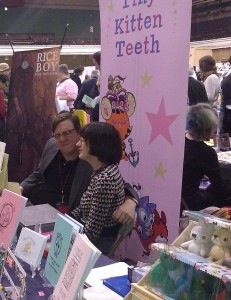§ So what was the bottom line for last month’s C2E2? According to show runner Lance Fensterman, attendance was around 41,000, up from 2011’s 32,000. In general, he tells ICv2, the show was a success:
We are still in the process of getting feedback, and of course, we do really in-depth research with all of the audience after the show and we have some pretty scientific metrics that we use, but I am quite pleased with what we know now. We delivered a significantly larger audience than the previous year, which was needed because we had a significantly larger show floor of exhibitors than the previous year, and we needed those aisles full—and they were full on Saturday and Sunday. Friday the professional hours are always light. We are kind of rethinking what we might do with those professional hours. They might not be quite as relevant in the Chicago market, so we may limit that a little bit to keep the Friday crowd bigger and add value to that ticket for next year.
§ Chris Arrant looks at yet another aspect of the Kickstarter revolution—the way it functions as a kind of pre-ordering system:
In effect, it’s turning away from publishers as the primary source to fund a comic and instead taking advantage of the wills and pocketbooks of fans. What makes it even more powerful is the idea of prizes for pledge levels, becoming more than just a donation with no strings attached; in effect, you could pre-order editions of the book in different formats with different price levels. Take for example the recent Kickstarter drive for the Image graphic novel Queen Crab: It raised $10,000, and in the process pre-sold 278 print copies of the book and 47 PDFs. That’s before it was even solicited in Previews. With fans acting as angel investors of a sort, Kickstarter has given life to projects that might not have been published otherwise. Publishers like IDW and Image have picked up books like these where part of the money to fund the project is already paid for by fans. It’s pre-pre-ordering, in a way — showing support for a project so that it can get off the ground.
§ Matt Maxwell has a Stumptown fest report that’s also a teensy bit of a WonderCon report:
My single favorite part of the Stumptown Comics Fest, aside from the excuse to visit Portland? There is no Artist’s Alley. There is no small press area. There’s only comics in every aisle and at just about every booth. There’s publishers selling books and there’s creators selling books or minis or pages or sketches or whatever. I realize that this sort of arrangement is impossible for a big show, and kinda antithetical to the whole convention course we’re in. The big companies dominate and the little fish sorta dart around behind their tables, hoping that people come down the aisles. Of course, it’s tough to do tiered charging for tables if you just throw everyone in the mix like that, so like I said, understandable that it doesn’t happen at bigger shows. Stumptown does away with all that. It’s all comics. Web comics, art comics, superhero comics, weird genre-mashup comics, what have you. Nobody lined up by publisher. Everyone just out to be browsed. Kurt Busiek and Benjamin Marra in the same show, which is a weird kind of ersatz Alpha to Omega for someone out there, I’m sure.
But he also notes the retailing aspects of the indie show circuit:
For those of you keeping track at home, I sold in two days at Portland, about a third (or slightly more) in raw numbers than were ordered nationwide by Diamond. And that was just for THE THIRSTY. MURDER MOON, which Diamond has made clear they will not stock, sold just as much. And people wonder why exhibitor spaces and artist’s alley spaces at comic shows sell out months in advance. Wanna know why? Because that’s the new market. And people there are ready to buy more than Big Two comics. Granted, then all the risk/cost falls on the shoulders of the small publishers instead of the retailers, but them’s the breaks.
§ Speaking of indie shows, Gary Tyrrell of Fleen has a webcomic-centric look at the MoCCA just passed:
MoCCA 2012, Part One
MoCCA 2012, Part Two
MoCCA 2012, Part Three
The thing about Frank Gibson and Becky Dreistadt¹ is that they are living proof that all you need to be super-successful in any creative field is reasonably talented, a little lucky, and a completely insane,work longer and harder than anybody else and eat their friggin’ lunch machine. Like Becky does. She paints nonstop, moving from project to project, dropping beauty via gouache and watercolor the way other people accidentally drop a gum wrapper out of their jacket pocked while fumbling for their keys.
§ And continuing the indie theme, the National Post is running its annual series of pre-TCAF cartoonist profiles, so far with Benjamin Marra, Natalie Nourigat, etc., etc.





